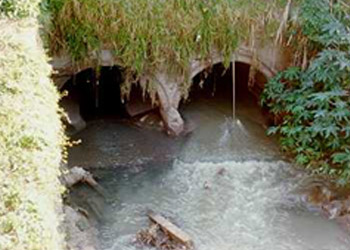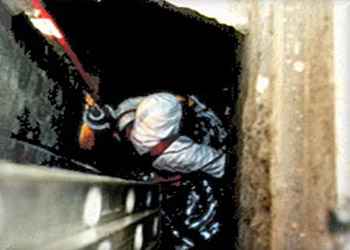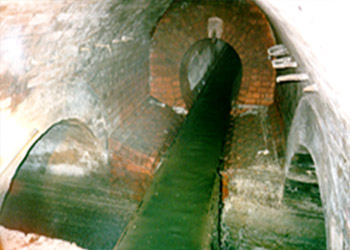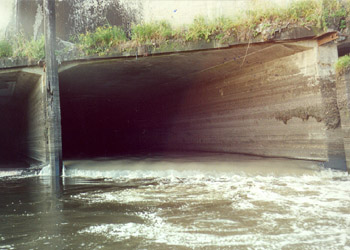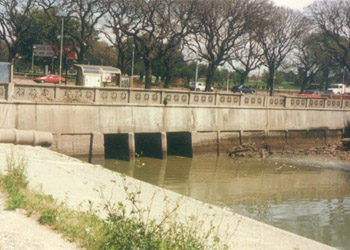Hydrometric measurements, water quality monitoring and technical studies in mathematical models in practically all the conduits and streams that drain the city of Buenos Aires, the northern area from the Luján River and the southern area to Punta Lara in the vicinity of La Plata , as well as in the discharges that discharge stormwater-sewage effluents to the Riachuelo. Systematic surveys with flow measurements and water quality sampling complemented with studies in mathematical models of hydraulic, sedimentological and water quality behavior.
STUDIES OF THE STORMWATER-SEWAGE SYSTEM OF THE CITY OF BUENOS AIRES AND NEARBY SECTORS
The work carried out in the stormwater-sewage drainage system of the city of Buenos Aires and the neighboring districts can be summarized as:
Monitoring of the stormwater-sewage discharges to the Río de la Plata located between the Delta and La Plata.
Measurements in the Reconquista and Luján rivers.
Monitoring of stormwater-sewage discharges to the Riachuelo
Measurements and Study of the Old Radio System of the city of Buenos Aires.
These monitoring and hydraulic studies were a fundamental information base for the development of the studies for the sanitation of the coastal strip, known as the Integral Sanitation Plan, which would later lead to the Riachuelo System, currently under construction, where the works are included of the Left Bank Interceptor of the Riachuelo, North Coastal Collector, Dock-Sud Treatment Plant and Subfluvial Outfall
The first works date back to the beginning of the 90s, with a detailed Inventory of these discharges, which was carried out by means of a photographic helicopter flight (it should be noted that tools such as Google Earth were not yet available), covering the entire coastline from the river mouth of the Luján River to Punta Lara (approximately 80 km of coastline). In this way, it was possible to identify all the conduits, ditches, streams and rivers that discharge their waters to the Río de la Plata. Then it was reconnoitred by land and water and the hydrometric measurements and corresponding water samples were carried out.
A little more than the twenty (20) main discharges that discharge to the Río de la Plata, were then systematically monitored during 5 years, with a variable periodicity between 3 and 6 months. Said monitoring consisted of flow measurements and water sampling to quantify the pollutant loads contributed and in the analysis of the hydraulic behavior of the same, particularly to take into account the effect of the tidal regime of the Río de la Plata. Among others, the discharge El Arca, 33 Orientales, Peru, Borges, Medrano, Vega, Maldonado, Ugarteche, Double and Triple Madero, Riachuelo, Sarandí, Santo Domingo, Giménez, Berazategui, Las Conchitas, El Gato, Canal del Este and Canal Oeste, Berisso.
Regarding discharges to the Riachuelo, the works were carried out on the main stormwater conduits located between Bridge La Noria and the river mouth, on both banks, including: Cildañez, Pergamino, Erezcano, Teuco, Elía and Perdriel to be intercepted in dry weather on the left bank and Espinosa, Dean Funes and Bravo on the right bank.
Also in the opportunity of a breakdown of the 3rd Maximum Sewer, with significant damage, the sewage effluents had to be diverted directly to the Riachuelo, during the repair works, EIH prepared and executed a monitoring plan in order to evaluate the environmental impact on the receiving media of these untreated spills. To do this, it implemented a Hydrodynamic and Quality Mathematical Model that allowed real-time monitoring of water quality during the execution of the repair works. The real-time monitoring and modeling tasks lasted for 60 days with continuous measurements of flows, levels and water quality of the stormwater collectors, among others: California, Funes, Av. O. Cruz, Goncalvez Días and Perdriel and they monitored the hydraulic and quality parameters in seven (7) bridges located between Ezeiza and the river mouth of the Río de la Plata, over a distance of the order of 27 kilometers.
Regarding the Old Radio duct system, which is a mixed stormwater-sewage conduction system, measurements were made at different points of the same to study its conduction capacity.
